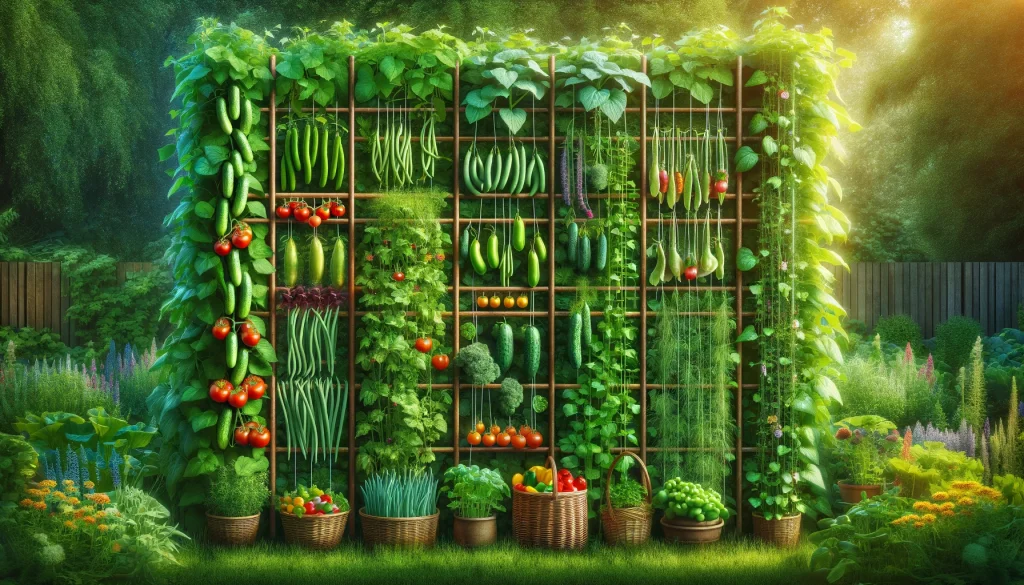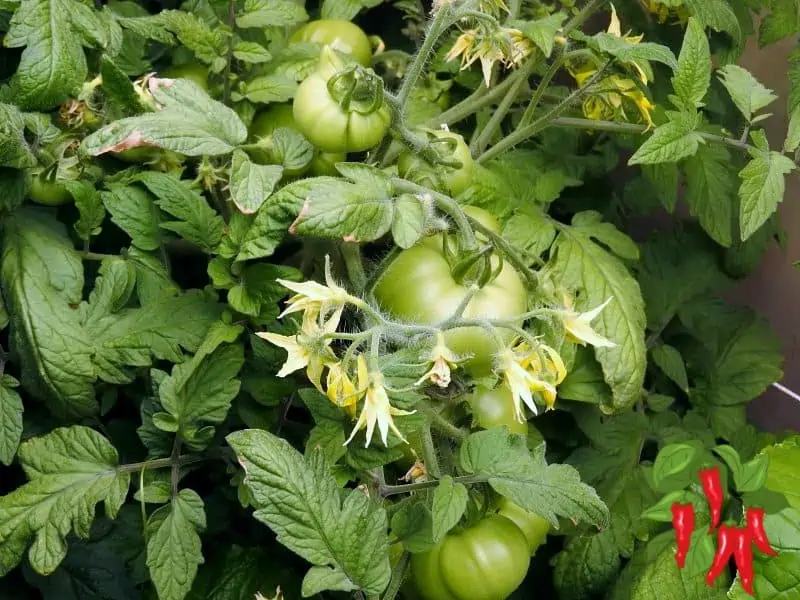This post may contain affiliate links. If you buy something from one of our links we may earn a commission. Thanks

Tired of running out of garden space? The best vegetables for vertical gardening can solve that problem by transforming your small garden into a lush, productive green haven.
Let’s explore how growing up instead of out can maximize your harvest and make your garden more efficient!
Best Vegetables for Vertical Gardening
Feeling cramped in your garden? Discover how the best vegetables for vertical gardening can turn even the smallest garden into a bountiful paradise.
With a little creativity, you can grow a variety of vining plants upwards and make room for shorter plants like lettuce, greens, and strawberries lower down.
Vertical gardening is a technique you can take advantage of whether you garden outdoors, on a balcony, or even indoors.
Let’s explore how vertical gardening can maximize your space and yield!
1. Summer Squash
Summer squash, like zucchini, can be a bit unruly in the garden, but they can be tamed vertically.
Use twine to train the vines up a sturdy trellis, and support the squash with slings to prevent the fruit from weighing down and breaking the vines.
2. Cantaloupe
Growing cantaloupe vertically can save space and keep the fruit cleaner. Choose smaller varieties and use slings to support the melons as they grow.
This helps prevent the vines from snapping under the weight of the fruit.
Growing Cantaloupe Vertically
3. Watermelon
Like cantaloupe, watermelon can be grown vertically if you select smaller varieties. Make sure to support the fruit with slings to avoid breaking the vines.
Varieties like ‘Golden Midget’ and ‘Sugar Baby’ are great choices for vertical gardens.
4. Grapes
Grapevines are perennial plants that can produce fruit year after year. They require a sturdy, permanent structure like an arbor to support their growth.
Grapes need regular pruning to keep them healthy and productive.
5. Cucumbers
Cucumbers are perfect for vertical gardening. Growing them vertically keeps the fruit clean and off the ground, reducing the risk of diseases and making it easier to spot and harvest ripe cucumbers.
6. Indeterminate Tomatoes
Indeterminate tomatoes, or vining tomatoes, thrive when grown vertically. Use a trellis, cage, or stakes to support the plants.
This method keeps the plants off the ground, improving air circulation and reducing disease risk.
7. Peas
Peas, including snap peas, snow peas, and garden peas, are excellent for vertical gardening.
Their tendrils naturally cling to supports, making them easy to grow on a trellis or netting.
8. Pole Beans
Pole beans, also known as green beans, are vigorous climbers that benefit from vertical gardening.
They produce continuously throughout the season, unlike bush beans, which have a shorter production period.
9. Jicamas
Jicamas are a less common root vegetable but can be grown vertically. Use a trellis to support the vines and save space in your garden.
10. Pumpkins
While large pumpkins aren’t suitable for vertical gardening, smaller varieties like ‘Jack Be Little’ can be grown vertically with proper support.
Use slings to hold the weight of the pumpkins as they grow.
11. Strawberries
Strawberries are great for vertical gardening in containers or hanging baskets. This method saves ground space and keeps the berries clean and easy to harvest.
 Mr. Stacky 5-Tier Strawberry Planter Pot
Mr. Stacky 5-Tier Strawberry Planter Pot
12. Greens
Leafy greens like spinach and lettuce can be grown vertically in stacked planters or wall-mounted systems. This method allows for easy access and harvesting.
13. Malabar Spinach
Malabar spinach is a vining variety of spinach that thrives in warm climates. It can be grown vertically on a trellis, providing a continuous supply of nutritious leaves.
14. Peppers
Peppers, including bell peppers and hot peppers, can be trained to grow vertically. Use stakes or cages to support the plants and keep them upright.
15. Blackberries
Blackberries are vigorous climbers that can be grown on a trellis. Training them vertically helps manage their growth and makes harvesting easier.
16. Raspberries
Raspberries can also be grown vertically. Using a trellis to support the canes keeps the plants manageable and improves air circulation, reducing the risk of disease.
Vertical gardening not only saves space but also improves air circulation and reduces the risk of pests and diseases. With the right support and care, you can enjoy a bountiful harvest from your vertical garden.
Best Vegetables for Vertical Gardening Conclusion
Vertical gardening is a fantastic way to maximize space and increase your vegetable yield.
You can transform a small garden into a productive and beautiful space by choosing the right vegetables and fruits and providing the proper support.
Whether you’re growing cucumbers, tomatoes, or even squash, vertical gardening can help you get the most out of your garden.
Read more: Indoor Vertical Gardening: Start Your Indoor Garden Now
Key Takeaways
- Vertical gardening saves space and improves air circulation.
- Ideal vegetables for vertical gardening include cucumbers, tomatoes, pole beans, and peas.
- Use sturdy supports and slings to help heavy fruits grow vertically.
- Vertical gardening makes harvesting easier and reduces the risk of pests and diseases.
By incorporating these tips and tricks, you’ll be well on your way to creating a thriving vertical garden!
Visit my Amazon Influencer Page for videos and gardening products Grow Your Own Garden






